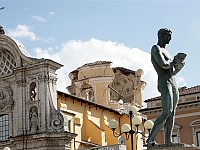
Only a few countries have as much to offer to their tourists regarding cultural heritage as Italy. However, nations like Spain, France, UK, and Germany are known to invest much more in tourism and their heritage then Italy and thus are more competitive.
Italy is home to the largest amount of UNESCO world heritage sites in the world. Excluding the Vatican, there are roughly 51 heritage sites, including the Stone Age wall murals, an Etruscan necropolis, Greek temples, villas of Roman emperors, settlements such as Pompeii, and the historic city centers of Rome, Florence and Naples with their impressive Renaissance Palazzos and breathtaking Baroque churches.
Cultural Heritage Is Underinvested
Italians are rightfully proud of their cultural heritage, but the country does not do well when it comes to economically benefitting from it. When compared to its European rivals, the country falls short in regards of investments in the historical sites and in competitive ability. Therefore, the revenue from tourism and its slice of the GDP is much lower than it might be. Furthermore, this sector employs much fewer people than it does in other countries.
In 2015, 53 million foreign tourists visited Italy, placing it on rank 5 – behind France, the US, Spain and China. According to a recently published statistic by the World Travel and Tourism Council (WTTC), Italy’s tourism industry made a revenue of EUR 68.8 billion. This equals a contribution to the gross domestic product of 4.2%, significantly less than in other European states. In 2015, Germany made EUR 117.9 billion, UK made EUR 85.8 billion, and France generated EUR 80.4 billion.
According to experts, Italy falls short of its potential. In 2009, PricewaterhouseCoopers derived from their study that France and UK make four to seven times more out of their (smaller) cultural heritage on the financial level. Back then, the consulting firm saw a great potential for growth in Italy.
Nowadays, the country’s handicaps have grown even larger. While the number of international tourists worldwide grew by 75% to 1.2 billion people between 2001 and 2015, Italy only recorded an increase of 48%. Furthermore, guests only stay a short while and spend less. In 2001, tourists stayed on average for 4.1 days and spent EUR 1035 on their trip, which decreased to 3.6 days and EUR 676 in 2015.
On a global scale, the industry made 7.2 trillion USD in 2015 and supplied jobs for 284 million people, according to WTTC. This means that every 11th employee works in the tourism industry. In Italy, that’s 1.1 million people which corresponds to 5% of all workers. In Germany, 3 million people or 7% of all workers are employed in tourism.
Problems with Public Transport
For decades, the administration of Rome has invested relatively small amounts into its cultural heritage and the tourism industry, which has only increased in times of the recent economic crisis. In 2015, Italy invested EUR 8.7 billion into tourism, which amounts to 3.2% of its overall investments. This places Italy on the 137th place in the rank of WTTC. For comparison, last year, France invested EUR 29.8 billion (6.4%) and Spain EUR 16.9 billion (7.7%).
The worst situation is in southern Italy. Only 12% of tourists in the country visited the regions of the Mezzogiorno in 2015 while the northern region Veneto absorbed more than 20%. In the south however there are not only the country’s most beautiful beaches but also 18 UNESCO heritage sites. They are sadly neglected due to the small budget. On top of that, archaeological sites often get raided by criminals harming the cultural heritage immensely.
In the Tourism Competitiveness Index 2015 Italy lies behind Spain, France, Germany, the USA, UK, Switzerland, and Australia on the 8th place. All of this in spite of the top grade it receives for its cultural heritage and wilderness. The competitive nature of its rivals should make Rome rethink its position.
The problem seems to be in Italy’s transport infrastructure. Those who often use the airport of Rome won’t be surprised. Delays are a common occurrence and the number of lost luggage is much higher than anywhere else. After a fire last spring, the airport only operated with strict limits for months because owners and unions were unable to agree on the reorganization plan. The public transport in Rome and other Italian cities can hardly compete with other countries due to the lack of budget and constant strikes.
According to the WTTC index, the industry also has to face a bad business climate and high taxes. In this area, Italy came in on 127th place. Another problem can be found in its price-performance-ratio (133rd place). While its gastronomic supply and service traditionally tends to be excellent, the same areas are lacking with regards to hotels. Especially in larger cities, hotels and pensions are overpriced.










